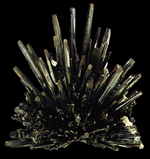|
|
| Formula: | Sb2S3 |  Click to see a larger image |
||
| Crystal: | Orthorhombic | |||
| Hardness: | 2 | |||
| Spec. Gr.: | 4.63 | |||
| Streak: | Lead-gray | |||
| Cleavage: | Parallel to length | |||
| Location: | Baia Mare, Romania |
| Stibnite has been known and used since ancient times. Its name is from the Greek STIBI, a silver-gray makeup for darkening the eyelids. The Roman naturalist Pliny described it as a cosmetic preparation much in use at the time. Stibnite is an antimony sulfide, with 71.4 percent being antimony. Its crystals tend to radiate in columnar bunches of rods which are heavily striated along the length. It terminates, occasionally doubly, in pointed pyramids. It associates easily with cinnabar, orpiment and realgar. In Japan, single crystals were so plentiful, they were used as fence posts in miniature gardens. Stibnite is the main source of antimony and is used in the production of very hard alloys, and is used for printing type. Fine crystals up to nearly a meter in length were found in the Ichinokawa mine on Shikoku Island in Japan; at Manhatten, Nevada; and at Baia Mare, Romania. |
|
Bibliography: Svenek, Jaroslav, Minerals, 1987, pp. 64-65. Bancroft, Peter, Gem and Crystal Treasures, 1984, pp. 442-445. |
|
University of California, Santa Barbara—Department of Earth Science Copyright © 2005 Regents of the University of California Send your comments to the Web Page Editor |